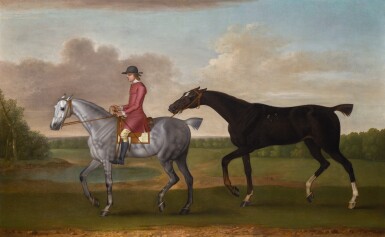
JAMES SEYMOUR | The Duke of Kingston’s liver chestnut racehorse 'Jolly Roger' led by a groom
Auction Closed
December 5, 12:50 PM GMT
Estimate
120,000 - 180,000 GBP
Lot Details
Description
JAMES SEYMOUR
London 1702-1752
The Duke of Kingston’s liver chestnut racehorse 'Jolly Roger' led by a groom
signed lower right: J:S / 1750.
oil on canvas
77.5 x 123.8 cm.; 30½ x 48¾ in.
Mr and Mrs Jack R. Dick;
Their sale, London, Sotheby's, 23 April 1975, lot 136, for £23,000;
Simon Sainsbury (1930–2006);
His sale, London, Christie's, 18 June 2008, lot 105, for £241,250.
The identification of the racehorse in this picture is suggested by the colours worn by the groom, which is the crimson livery of Evelyn Pierrepont, 2nd Duke of Kingston (1711–73). Jolly Roger by Stamford's Mogul, a son of the Godolphin Arabian, out of a Partner mare, was foaled in 1743. During the period running up to 1750, the date of this painting, the duke’s only runner was Jolly Roger. The horse ran in five races between 1748 and 1751, winning three of these – Peterborough in 1749 where he won £50 beating three others in only two heats, Lincoln in the same year where he won £80 beating his only rival in two heats, and Grantham in 1751 where he won £50 beating four others. His career at Newmarket was less successful, coming third to Lord Portmore’s Skim. His final victory was in a race which carried a proviso that the other owners could buy the winner for £300. Presumably this happened, and in 1751 the horse was sent over to America by John Spotswood, a landowner from Spotsylvania County, Virginia. He became a distinguished sire in the years up to his death in 1769.
The Duke of Kingston led a colourful life dominated by his love of women and gambling. He was an early member of the Jockey Club and owned horses on quite a large scale. It seems that he acquired his taste for racing from his ownership of Jolly Roger, as his entry into that world only really took off four or five years after the sale of that horse. He owned substantial property in the north of England but his main residences were Thoresby Park and Holme Pierrepont Hall. The landscape in this picture suggests Thoresby Park by the lake. The house built at Thoresby by the 2nd Earl of Kingston in around 1670 had been destroyed by fire in April 1745 and a new house by Carr of York was completed twenty years after this picture was painted.
We are grateful to both David Oldrey and Richard Wills for their help in cataloguing this picture. It will be included in Wills' forthcoming catalogue raisonné on James Seymour.
